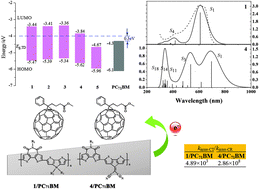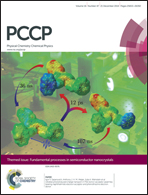A designed bithiopheneimide-based conjugated polymer for organic photovoltaic with ultrafast charge transfer at donor/PC71BM interface: theoretical study and characterization†
Abstract
In the current work, a series of bithiopheneimide (BTI)-based D–A copolymers were investigated based on the reported PDTSBTI (1) to screen excellent molecules toward organic photovoltaic (OPV) donor materials. It is found that the PCE based on the proposed derivative 4, where the silicon atom is replaced with vinyl and cyano groups on the DTS unit, shows a 70 percent improvement by Scharber diagrams compared with its prototype 1. Then, the charge transfer dynamics of 1/PC71BM and 4/PC71BM were investigated, including the intermolecular charge transfer (inter-CT) and recombination (inter-CR) rates. The theoretical data demonstrate that the ratio kinter-CT/kinter-CR of 4/PC71BM heterojunction is about 1 × 105 times higher than that of 1/PC71BM. These results clearly reveal that the designed donor molecule 4 will be a promising candidate for high-performance OPV device. We expect that this work from electron processing at the D/A interface may provide a theoretical guideline for further optimization and design of organic copolymer donor materials.

- This article is part of the themed collection: Charge Generation Mechanism in Organic Solar Cells

 Please wait while we load your content...
Please wait while we load your content...